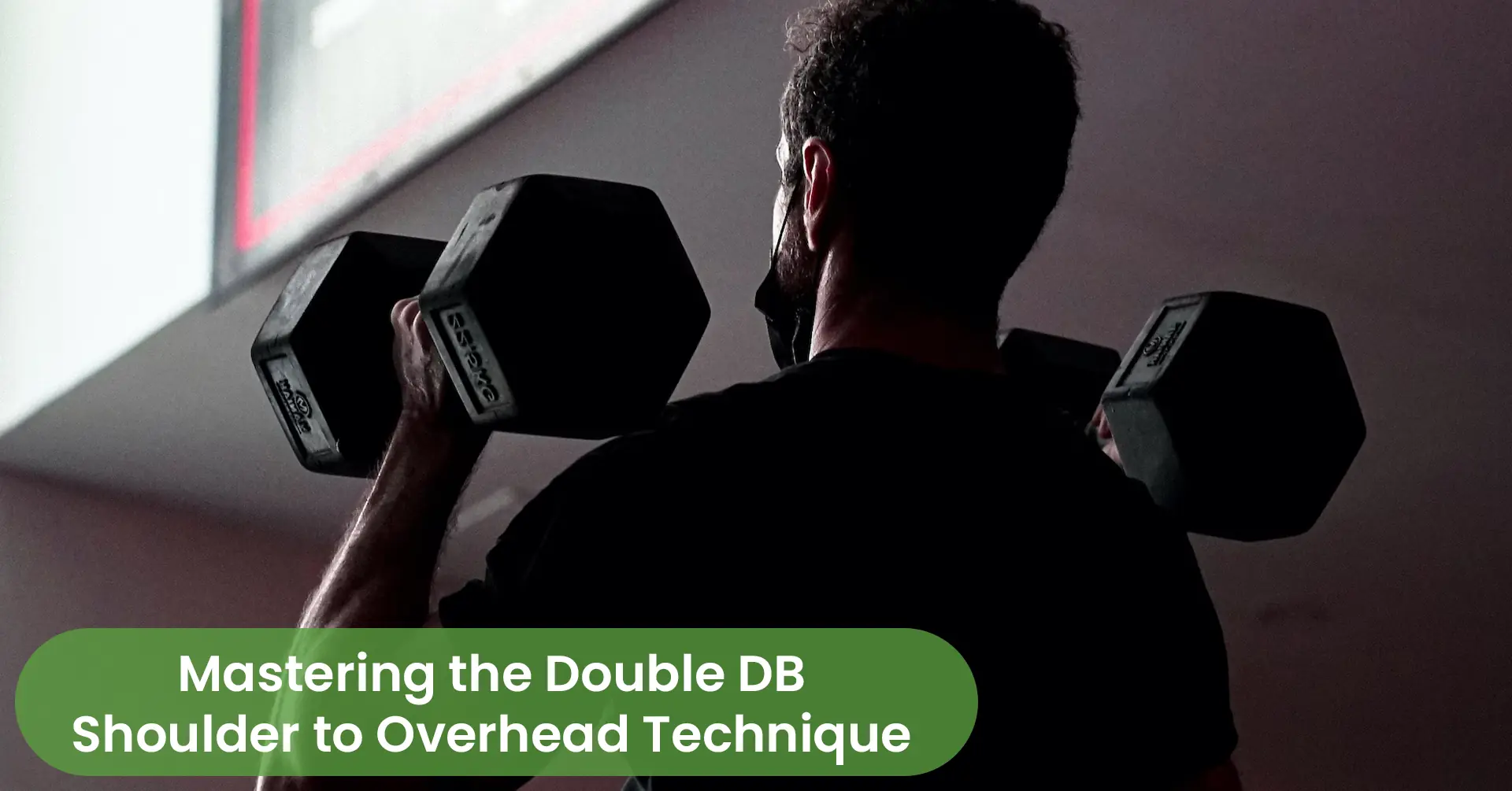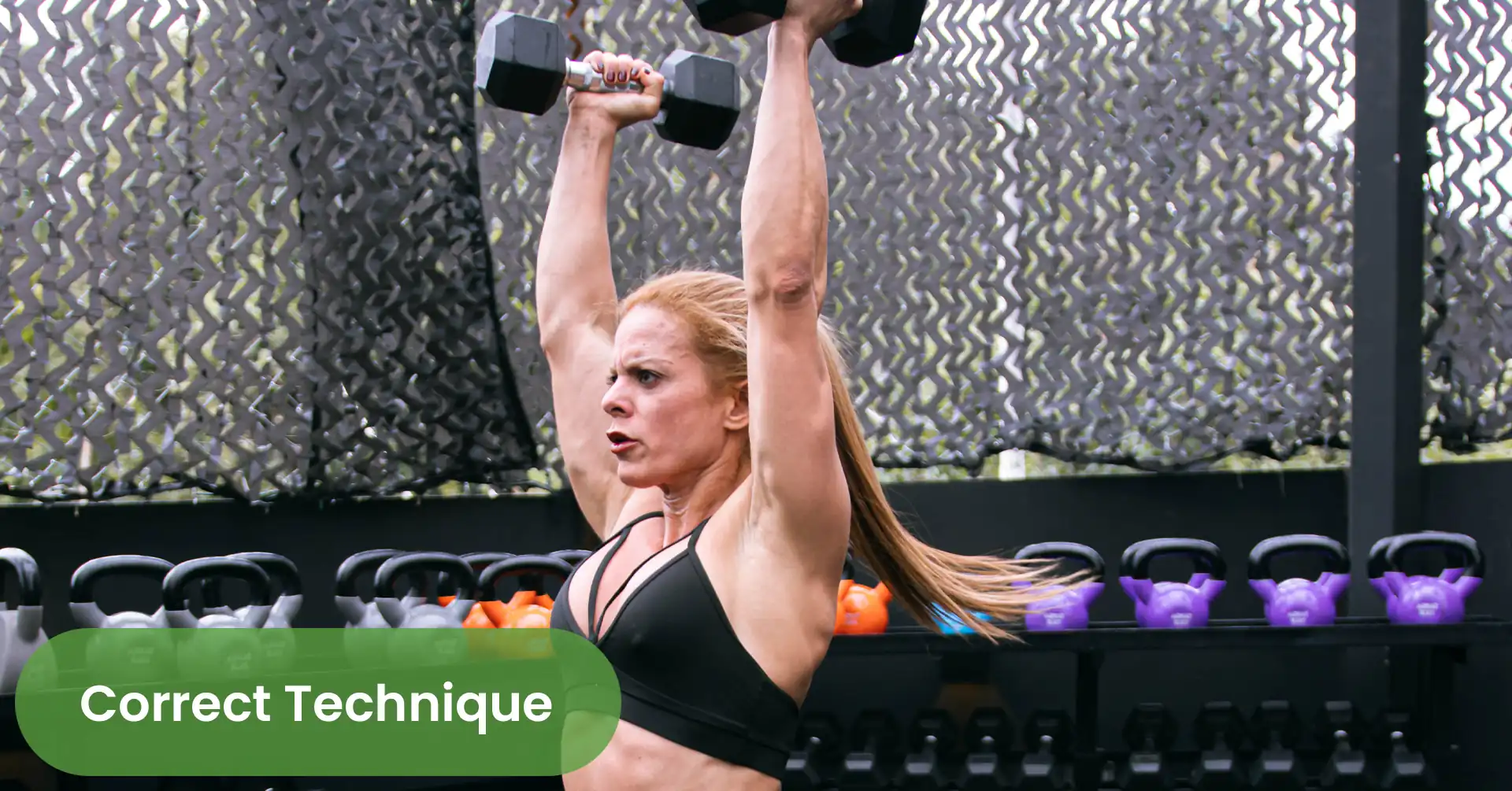
Are you looking for a challenging exercise to take your fitness routine to the next level? Look no further than the Double DB Shoulder to Overhead. This compound movement targets multiple muscle groups, including the shoulders, back, arms, and core, making it an excellent addition to any strength-training program.
In this blog post, we will delve into the techniques and benefits of the Double DB Shoulder to Overhead. You'll learn how to perform this exercise correctly, how to modify it for different fitness levels, and what benefits it offers for your overall health and fitness. Whether you're a beginner or an experienced lifter, this post will provide you with valuable information to help you master this challenging movement.
So, are you ready to take your fitness game to the next level? Let's dive in and explore the world of Double DB Shoulder to Overhead!
Overview of Dumbbell Shoulder to Overhead Exercise
The Dumbbell Shoulder to Overhead exercise is a compound movement that targets multiple muscle groups, including the shoulders, back, arms, and core. This exercise is performed by holding a pair of dumbbells at shoulder height and then pressing them overhead until the arms are fully extended.
To perform the exercise correctly, it's important to maintain proper form throughout the movement. Begin by standing with your feet shoulder-width apart, holding the dumbbells at shoulder height with your palms facing forward. Then, press the dumbbells overhead in a controlled manner, making sure to keep your elbows close to your body and your core engaged.
The Dumbbell Shoulder to Overhead exercise can be modified for different fitness levels by adjusting the weight of the dumbbells and the number of reps performed. It can also be incorporated into various workout routines, such as strength training or high-intensity interval training (HIIT).
Some benefits of the Dumbbell Shoulder to Overhead exercise include improving shoulder and core strength, increasing upper body muscle mass, and enhancing overall fitness. It's important to start with lighter weights and gradually increase the weight as you become more comfortable with the exercise. As with any exercise, it's also important to consult with a healthcare provider before beginning a new workout routine.
Also read: Master the Ground to Overhead Crossfit Training
Muscle Groups Targeted
The Dumbbell Shoulder to Overhead exercise primarily targets the muscles of the shoulders and upper back, specifically the deltoids (anterior, medial, and posterior), trapezius, and rotator cuff muscles.
In addition to the shoulders and upper back, the Dumbbell Shoulder to Overhead exercise also engages several other muscle groups, including the chest, triceps, biceps, forearms, and core muscles.
The chest muscles (pectoralis major and minor) are involved in stabilizing the weight during the pressing movement, while the triceps and biceps muscles assist in elbow extension and flexion, respectively. The forearm muscles, particularly the brachioradialis, are engaged as the weight is lifted and lowered.
Lastly, the core muscles, including the rectus abdominis, obliques, and erector spinae, are activated to help stabilize the body and maintain proper posture throughout the movement.
Overall, the Dumbbell Shoulder to Overhead exercise is an excellent compound movement that targets multiple muscle groups and can help improve upper body strength and overall fitness.
Correct Technique

The Dumbbell Shoulder to Overhead exercise is an effective compound movement that targets the shoulders, upper back, and core muscles. To perform this exercise with proper form, follow these steps:
- Begin by standing with your feet shoulder-width apart, holding a dumbbell in each hand at shoulder height with your palms facing forward. Keep your elbows close to your body and engage your core muscles.
- Slowly press the dumbbells overhead, fully extending your arms, while exhaling. Keep your shoulders down and back and maintain a neutral spine throughout the movement.
- Pause briefly at the top of the movement, then slowly lower the dumbbells back down to the starting position while inhaling.
- Repeat for the desired number of repetitions.
Some tips to keep in mind while performing the Dumbbell Shoulder to Overhead exercise include:
- Avoid arching your back or leaning forward during the movement.
- Keep your elbows close to your body throughout the exercise.
- Engage your core muscles to maintain proper posture and stability.
- Use a weight that is appropriate for your fitness level and allows you to perform the exercise with proper form.
- Breathe in during the eccentric (lowering) phase and breathe out during the concentric (lifting) phase of the exercise.
By following these tips and maintaining proper form, you can safely and effectively perform the Dumbbell Shoulder to Overhead exercise to improve your upper body strength and overall fitness.
Modifications for Different Fitness Levels
The Dumbbell Shoulder to Overhead exercise can be modified to accommodate different fitness levels. Here are some modifications you can make:
- Beginner Modification: If you are new to strength training or are just starting to incorporate the Dumbbell Shoulder to Overhead exercise into your routine, start with a lighter weight and focus on proper form. Begin by using only one dumbbell instead of two, and perform the exercise with both arms simultaneously. This modification will help you to build your strength and develop proper technique.
- Intermediate Modification: Once you feel comfortable with the exercise and can perform it with proper form, you can increase the weight of the dumbbells or perform the exercise with one arm at a time. These modifications will increase the intensity of the exercise and help to further develop your upper body strength.
- Advanced Modification: If you are an experienced lifter and want to challenge yourself, you can perform the Dumbbell Shoulder to Overhead exercise with heavier weights, or perform the exercise with one arm while holding a heavier weight in the opposite hand. You can also add a pause at the top of the movement, or perform the exercise as part of a high-intensity interval training (HIIT) routine.
Remember to always listen to your body and adjust the weight and intensity of the exercise based on your fitness level and individual needs. By modifying the Dumbbell Shoulder to Overhead exercise, you can continue to challenge yourself and make progress toward your fitness goals.
Equipment Needed
The Dumbbell Shoulder to Overhead exercise requires a pair of dumbbells. The weight of the dumbbells you use will depend on your fitness level and goals.
When selecting dumbbells for this exercise, it's important to choose a weight that challenges you without compromising your form. Beginners may want to start with lighter weights, while more experienced lifters may be able to use heavier weights.
In addition to the dumbbells, you may also want to use a weight bench or chair for seated variations of the exercise. Some gyms may have adjustable benches specifically designed for the Shoulder to Overhead exercise. However, if you don't have access to a bench, you can perform the exercise while standing or sitting on a stable chair.
Other helpful equipment to have on hand includes a workout mat or towel to provide cushioning for your knees or to protect the floor, and a water bottle to stay hydrated during your workout.
Benefits of Double DB Push Press
The Double DB push press is a compound exercise that targets multiple muscle groups, primarily the shoulders, upper back, triceps, and core muscles. In addition to strengthening these muscles, the Double DB push press provides several benefits for overall fitness, including:
- Increased Upper Body Strength: The Double DB push press is an excellent exercise for increasing upper body strength. By using both arms to press the weights overhead, you can lift heavier weights and challenge your muscles to work harder.
- Improved Muscle Endurance: Performing the Double DB push press for multiple repetitions can help improve muscle endurance, allowing you to perform other exercises with more ease.
- Increased Power and Explosiveness: The Double DB push press involves generating power and explosiveness to lift the weights overhead, making it a valuable exercise for athletes or individuals looking to improve their power output.
- Enhanced Core Stability: The Double DB push press requires engagement of the core muscles to stabilize the body and maintain proper posture throughout the movement. This can help improve overall core stability and reduce the risk of injury.
- Improved Functional Strength: The Double DB push press is a functional exercise that mimics movements performed in everyday life, such as lifting and pushing overhead. By improving your strength and technique with this exercise, you can enhance your ability to perform everyday tasks with ease.
Overall, the Double DB push press is a versatile exercise that can provide numerous benefits for overall fitness and athletic performance. Incorporating it into your workout routine can help you improve your upper body strength, endurance, and power, while also enhancing core stability and functional strength.
Common Mistakes to Avoid

To get the most out of your Double DB push press exercise and avoid injury, it's important to perform it with proper form. Here are some common mistakes to avoid:
- Rounding the Back: One of the most common mistakes is rounding the back during the pressing movement. This can put unnecessary stress on the spine and increase the risk of injury. Instead, keep your back straight and core engaged throughout the exercise.
- Allowing the Elbows to Flare Out: When pressing the weights overhead, it's important to keep your elbows close to your body. Allowing your elbows to flare out can put undue stress on the shoulders and decrease the effectiveness of the exercise.
- Using Too Much Weight: Using too much weight can compromise your form and increase the risk of injury. Start with a lighter weight and gradually increase as you become more comfortable with the exercise.
- Not Engaging the Core: Engaging the core muscles is essential for stabilizing the body and maintaining proper posture during the exercise. Failing to engage your core can put extra stress on the lower back and reduce the effectiveness of the exercise.
- Rushing the Movement: The Double DB push press is a dynamic movement that requires power and control. Rushing through the exercise can compromise your form and increase the risk of injury. Instead, focus on performing each repetition with proper form and control.
By avoiding these common mistakes and focusing on proper form, you can perform the Double DB push press with confidence and reduce the risk of injury while getting the most out of this challenging exercise.
Variations of Double DB Shoulder to Overhead
The Double DB Shoulder to Overhead exercise can be varied to target different muscle groups or to add variety to your workout routine. Here are some variations of the exercise:
- Single-Arm Shoulder to Overhead: Instead of using two dumbbells, hold one dumbbell in one hand and perform the Shoulder to Overhead exercise with one arm at a time. This variation targets each arm individually and can help to correct muscle imbalances.
- Seated Shoulder to Overhead: Sit on a bench or chair and perform the Shoulder to Overhead exercise with both dumbbells. This variation places less stress on the lower body and can be beneficial for those with knee or ankle injuries.
- Alternating Shoulder to Overhead: Hold one dumbbell in each hand and perform the Shoulder to Overhead exercise, alternating which arm you lift overhead with each repetition. This variation can help to improve coordination and challenge your core stability.
- Arnold Press: Begin with the dumbbells at shoulder height with your palms facing your body. As you press the weights overhead, rotate your palms to face forward. Lower the weights back down while rotating your palms back to face your body. This variation targets the shoulders and chest muscles while also engaging the biceps and forearms.
- Dumbbell Clean and Jerk: Begin with the dumbbells at your sides, perform a clean to bring the weights to your shoulders, then press the weights overhead. Lower the weights back down and perform a second clean to return to the starting position. This variation targets the entire body and is a more advanced exercise.
Incorporating these variations into your workout routine can add variety and challenge to your exercise program, while also targeting different muscle groups for a well-rounded workout.
Conclusion
The Double DB Shoulder to Overhead exercise is a challenging compound movement that targets multiple muscle groups, including the shoulders, upper back, and core muscles. By performing this exercise with proper form and technique, you can improve your upper body strength, endurance, and power output.
In addition to the traditional DB Shoulder to Overhead exercise, there are several variations that can add variety to your workout routine and target different muscle groups. By incorporating these variations, you can continue to challenge yourself and make progress toward your fitness goals.
It's important to remember to start with a weight that is appropriate for your fitness level and to gradually increase the weight as you become more comfortable with the exercise. Always listen to your body and adjust the weight and intensity of the exercise based on your individual needs.
By incorporating the DB Shoulder to Overhead exercise into your workout routine, along with its variations, you can improve your overall fitness and athletic performance while developing a stronger, healthier body.